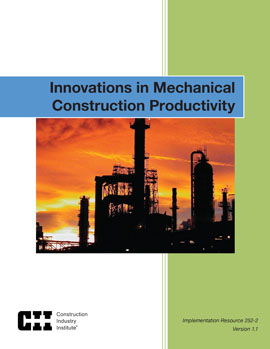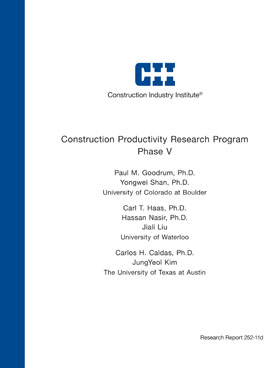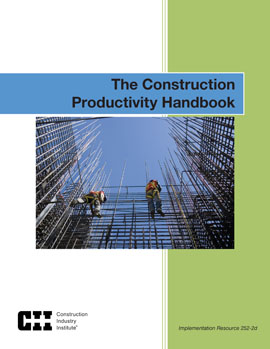
Innovations in Mechanical Construction Productivity, Version 1.1
Given that productivity is typically measured at 25 percent under or over the norm on any project, it is difficult to imagine improving craft productivity up to 50 percent. Analysis by CII Research Team (RT) 252 demonstrates that, independent of environmental factors, the variability of productivity is related to practices and tools. In fact, the use of best productivity practices correlates with 40–60 percent improvements in productivity. A project that implements these practices can potentially be 50 percent more productive than a project that does not.
Best productivity practices for the mechanical trades in particular are identified in this implementation resource, based on analysis of extensive CII Benchmarking and Metrics (BM&M) data. These practices can be grouped into five main areas:
- automation and integration
- materials management
- safety
- team building
- front end planning.
More conventional and generally accepted practices (e.g., scheduling, construction methods analysis, among others) may also correlate with improved productivity; however, because CII does not collect data on these practices, evidence for their effectiveness comes from the experience and judgment of construction management experts. These kinds of practices and those identified through CII BM&M data analysis are synthesized into the Best Productivity Practices Implementation Index (BPPII) described in previous RT 252 documents. The team will continue its efforts to discover and develop innovations in practices, since relentlessly searching for such innovations is itself a best productivity practice.
Innovative tools for improving productivity have also been discovered by RT 252. To date, the team has discovered and verified tools that must be considered significant productivity innovations. Within their limited scope of application, the team’s independent analysis has determined that each of the following mechanical innovations has the potential to improve productivity by as much as 60 percent:
- weldless and modularized pipe support systems
- laser scanning
- weldless pipe tree installation
- elimination of cut-lengths
- innovative scaffolding
- weldless pipe connections.
Separate chapters of this implementation resource are devoted to each of these innovations, with sections on 1) problem addressed, 2) description of innovation, 3) evaluation of labor productivity and cost improvements of each innovation, and 4) implementation guidelines. While the team has shown through objective case studies that these innovations significantly improve mechanical productivity, they are by no means exhaustive. Other innovations exist that can improve mechanical productivity. However, the six innovations that were selected for investigation were chosen on the basis of the program’s resources and on the team’s ability to collect independent data. Furthermore, the discussion of these six innovations in this implementation resource does not imply CII’s endorsement of their use. In summary, this document describes innovations and practices that can be implemented on any organization’s next project. If they are implemented, productivity improvements as high as 50 percent are possible
IR252-2, Innovations in Mechanical Construction Productivity, Version 1.1
Best productivity practices for mechanical trade identified and grouped into 5 main areas described in this resource. Projects that implement these practices have potential to improve productivity by 50%.



